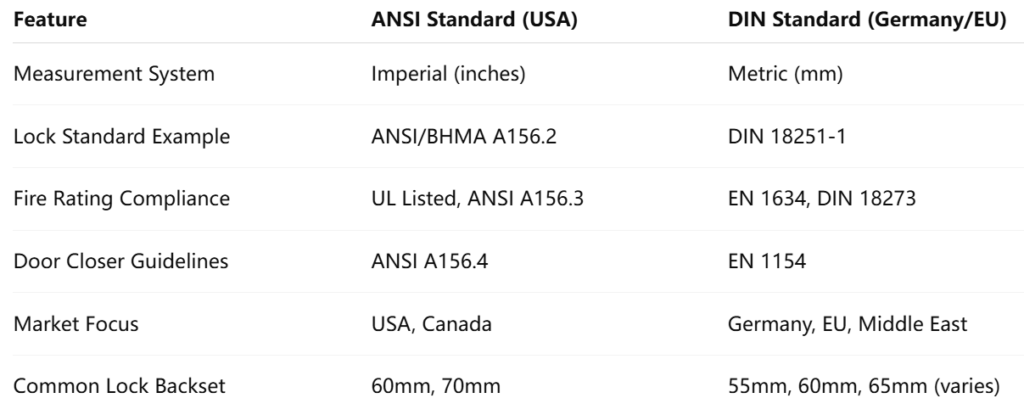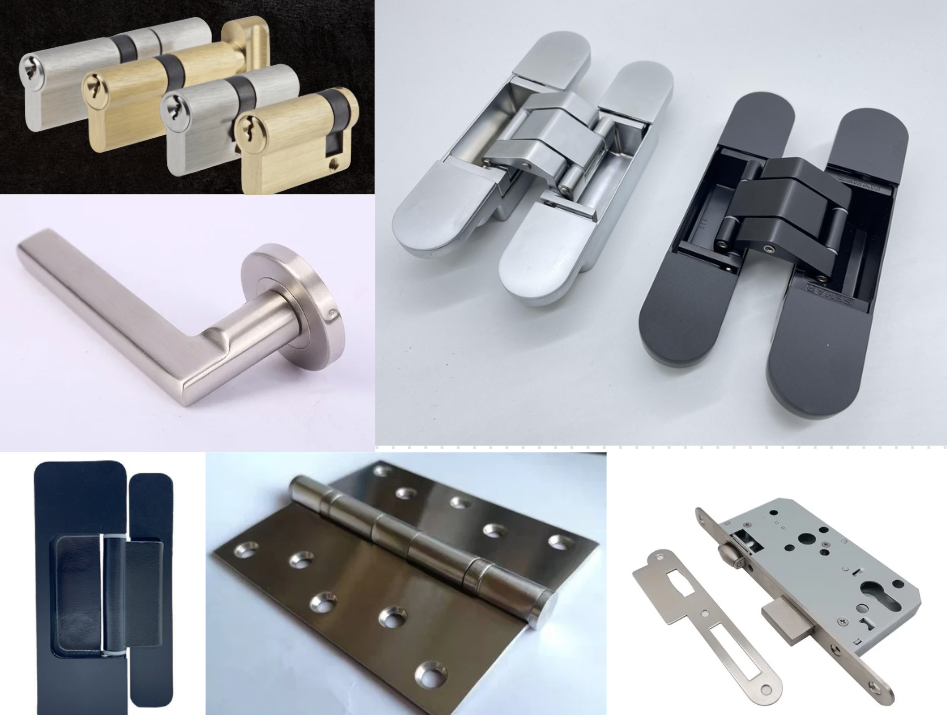In the global construction and architectural hardware industries, standards are more than just technical documentation — they are the foundation of compatibility, safety, and quality assurance. Whether you’re sourcing mortise locks, hinges, or door closers, understanding the differences between international standards like ANSI (American National Standards Institute) and DIN (Deutsches Institut für Normung) is essential.
In this article, we’ll explore how ANSI and DIN standards compare in the context of door hardware, and what it means for manufacturers, architects, and project managers working across different markets.
What Are ANSI and DIN?
ANSI – American Standards for the North American Market
ANSI oversees the development of voluntary consensus standards for products, services, and systems in the U.S. In the door hardware industry, the most relevant ANSI standards are developed by BHMA (Builders Hardware Manufacturers Association), and they cover everything from locksets and hinges to exit devices and closers.
Examples:
- ANSI/BHMA A156.1 – Hinges
- ANSI/BHMA A156.2 – Bored and mortise locks
- ANSI/BHMA A156.4 – Door closers
- ANSI/BHMA A156.3 – Exit devices
DIN – German Standards with European Influence
DIN is the German national standards organization, and its standards are often harmonized into EN (European Norms) used across the EU. DIN standards are known for their precision, metric system alignment, and detailed installation specifications.
Examples:
- DIN 18251-1 – Mortise locks for narrow or timber doors
- DIN 18273 – Fire-rated door hardware
- DIN EN 1154 – Door closers
- DIN 18272 – Hinges for rebated and flush doors
Key Differences in Door Hardware Standards
Let’s look at how ANSI and DIN standards differ across common door hardware categories.
🔒 Mortise Locks
- ANSI mortise locks are typically designed with standard backsets of 2-3/4” (70mm) or 2-3/8” (60mm). They usually follow a robust but slightly bulkier design.
- DIN mortise locks, such as those compliant with DIN 18251-1, have a more compact, rectangular shape with narrower faceplates and precise dimensions suited to aluminum, timber, or steel profile doors common in Europe.
✅ SDH mortise locks conform to DIN 18251-1, ensuring seamless installation in European-standard doors while offering high security and durability.
🔩 Hinges
- ANSI hinges are sized in inches (e.g., 4”x4”), and focus on load-bearing capacity and durability classification (Grade 1, 2, 3).
- DIN hinges define not just performance but also installation positioning, mounting patterns, and reversibility. DIN 18272 is often used alongside DIN 18273 for fire-rated applications.
🚪 Door Closers
- ANSI standards (e.g., A156.4) classify door closers by cycle life, performance under pressure, and adjustability.
- DIN (via EN 1154) classifies closers into power sizes (EN 2 to EN 6), based on door weight and width. Fire safety regulations are more stringent under DIN, requiring automatic closing under specific conditions.
🧯 Exit Devices & Fire Hardware
- ANSI focuses on UL listings and panic hardware performance (A156.3).
- DIN/EN requires compliance with EN 1125 (panic devices) and EN 1634 (fire testing), alongside DIN 18273 for fire-rated accessories.
Why These Differences Matter
When working across continents, overlooking these standards can cause serious compatibility and compliance issues:
- Mismatch in door prep and lock installation
A DIN lock won’t fit into an ANSI door cutout and vice versa without rework. - Certifications and fire codes
North American codes demand ANSI/UL-compliant hardware, while European buildings require DIN/EN compliance. - Project delays and cost overruns
Incorrect standards can lead to procurement errors, rejected products, or failed inspections.
For OEM manufacturers, understanding both systems is crucial to delivering region-specific solutions. For project specifiers, knowing which standard to follow ensures smooth integration and code compliance.
SDH’s Approach: Standards-Driven Design
At SDH, we manufacture a wide range of door hardware that meets the requirements of the DIN standard. Our mortise lock series complies with DIN 18251-1, making it an ideal choice for European-style timber doors, including applications that require precise backset, faceplate geometry, and fire-rated compatibility.
Quick Reference: ANSI vs. DIN Comparison Table

Conclusion: Choose the Right Standard for the Right Market
Both ANSI and DIN play vital roles in defining performance and safety in door hardware. Understanding their differences helps you choose the right products for the right applications, avoid costly installation issues, and ensure full compliance with local regulations.


